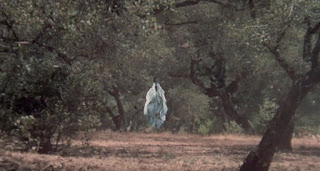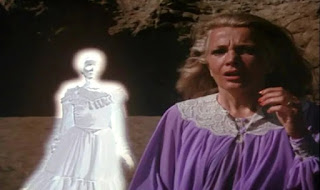(1989)
Dir - Graeme Clifford
Overall: MEH
Dir - Graeme Clifford
Overall: MEH
Producer Shelley Duvall switched her sights to the young adult market with Nightmare Classics; a short-lived anthology program for Showtime that followed the exclusively kid-friendly Faerie Tale Theatre and Tall Tales & Legends shows which she also created. The opening installment "The Turn of the Screw" is an adaptation of the famed 1898 Henry James novel and a redundant one at that, since the source material had been brought to both the small and big screen numerous times before and since. It has also been brought to the screen far better, particularly with Jack Clayton's lauded 1961 film The Innocents, a version that this one seems hellbent on learning nothing from. In place of still, increasingly eerie mood setting and rich, suggestive black and white photography, we have incessant and loud creepy music, overt supernatural sequences that leave nothing to the imagination, a bombastic finale, and a sterile color presentation fit for typical low-rent television productions. Amy Irving does an admirable job in the lead as the tormented governess, plus a young Balthazar Getty has the right smug and manipulative charm as the not-so-little Miles, even if he also is the only actor here without an English accent.
(1989)
Dir - Gabrielle Beaumont
Overall: MEH
Dir - Gabrielle Beaumont
Overall: MEH
Next up for Nightmare Classics was "Carmilla", retelling Joseph Sheridan Le Fanu's influential 19th century lesbian vampire story, this one featuring Meg Tilly as the blood-sucking seductress of the title. Given a Southern Gothic setting during the American Civil War where a deadly plague is rumored to be ravishing the countryside, Tilly shows up to woo away a plantation owner's daughter Ione Skye and nearly succeeds, being able to teleport, disappear, and summon a swarm of bats at one instance to due away with an interfering house servant. The undead rules here are equally willy-nilly, as Tilly is shown having no problem being outside in the day time yet flees from sunlight during the finale, also she keeps a barrage of other undead in close proximity to the plantation setting that no one notices until said finale. On the plus side, the actual night time shooting is atmospheric, plus Roddy McDowall shows up in a bad hair piece yet gets a surprisingly gruesome death scene where he is impaled on a wooden stake in the collapsed on the floor position. The made-for-TV presentation is still too sterilized, especially considering the more exploitative genre films that utilized different aspects of the source material to more titillating and gore-ridden effect.
(1989)
Dir - Michael Lindsay-Hogg
Overall: MEH
Dir - Michael Lindsay-Hogg
Overall: MEH
Taking its cue from the 1960 Hammer film The Two Faces of Dr. Jekyll and Mr. Hyde, Nightmare Classics' adaptation of the Robert Louis Stevenson novel The Strange Case of Dr. Jekyll and Mr. Hyde features an impish and unassuming Jekyll and a dashing Hyde, forgoing the usual tactic of the latter villain having a physically monstrous appearance. Unlike the aforementioned Hammer movie though, Anthony Andrews portrays Hyde without any semblance of charm, instead he is a humorless, smug, odious, and ill-tempered brute who terrorizes everyone around him as much as any other actor's interpretation has. Typical of the Showtime series, this is a stock and sterile television event that deserves little fanfare, tweaking several elements from previous versions yet merely being a competent retelling of a story that had long been done to death already by the end of the 1980s. British filmmaker Michael Lindsay-Hogg was not one to work in the horror genre regularly, and with no nifty monster transformation scenes or any memorable set pieces to work with, there is little that he can do under such confines. At least Laura Dern shows up as Jekyll's would-be love interest, with a British accent to boot.
(1989)
Dir - Noel Black
Overall: MEH
Dir - Noel Black
Overall: MEH
For the last of only four episodes in Shelley Duvall's Nightmare Classics, the series finally took a swing at some lesser-known source material, namely Ambrose Bierce's 1897 short story "The Eyes of the Panther". Though it inspired Val Lewton to pen his own tale "The Bagheeta" in 1930, (which would eventually lead to the celebrated RKO film Cat People), Bierce's story had never been given a proper cinematic treatment until here. Three years after infamously appearing in black face for Soul Man, C. Thomas Howell dons a lot of old crone makeup in order to chew the scenery, narrating a flashback of running into and then falling for a female werepanther some decades beforehand, played fittingly enough by Daphne Zuniga. Considering that cinematic felines are never frightening no matter what size or gender they are, (Noel Marshall's absurd "documentary" Roar notwithstanding), this episode is fighting an uphill battle from the onset. Also considering that the program was not equipped for hardly any special effects sequences, nor was it able to recreate any high-octane monster mayhem, it leads to a talky and dull affair that is as forgettable as the rest of the show was.


































